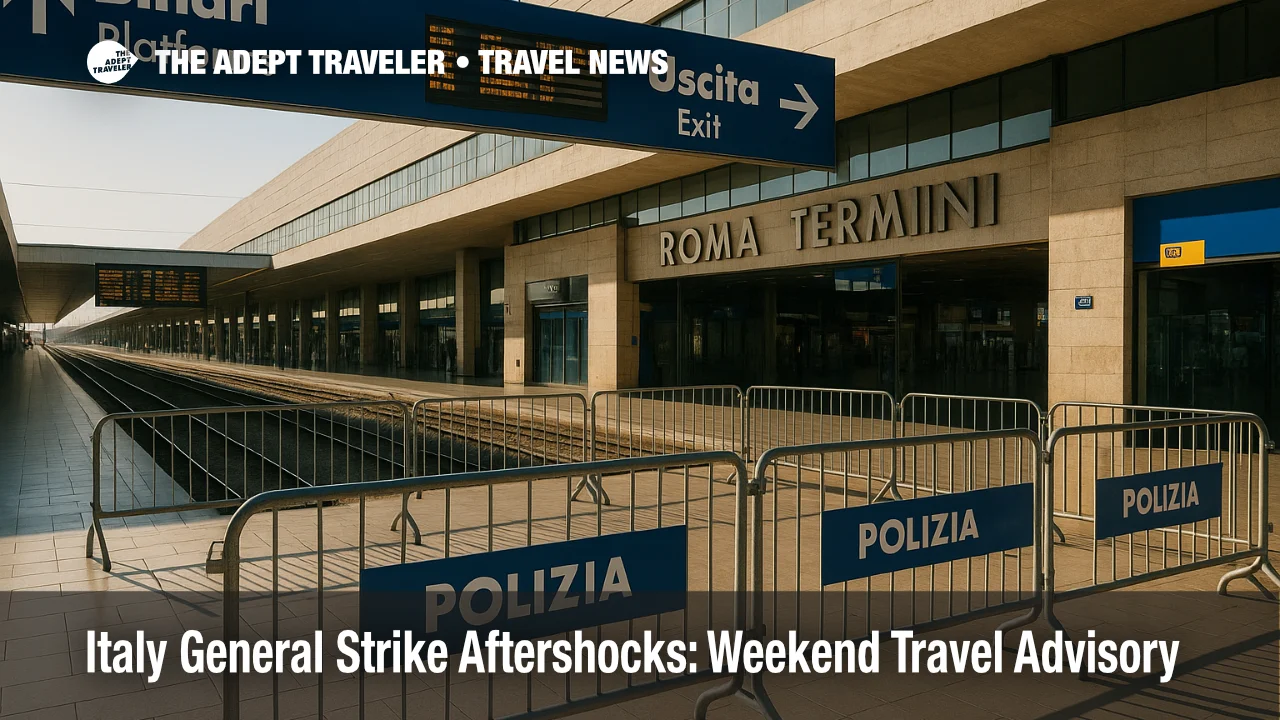Italy general strike aftershocks: Weekend travel advisory

A nationwide general strike on October 3 sparked large demonstrations and transport slowdowns across Italy, with the heaviest crowds in Rome and Milan. While national rail and local transit are returning to normal schedules, authorities expect residual rallies and rolling marches this weekend that could intermittently restrict access to Roma Termini and Milano Centrale. Travelers should build extra buffer when connecting through city centers and when transferring to Rome-Fiumicino International Airport (FCO) and Milan Malpensa Airport (MXP).
Key points
- Why it matters: Residual protests can choke access routes to Italy's busiest rail hubs and delay airport transfers.
- Travel impact: Expect crowding, police cordons, and brief street or station-entrance closures near Termini and Centrale.
- What's next: Marches are scheduled in Rome today; localized diversions may continue into Sunday. Allow extra time to reach FCO and MXP.
Snapshot
Friday's strike, led by major unions, disrupted parts of the rail network and local transit while drawing large crowds in Rome and other cities. In Milan, demonstrations spilled toward key corridors feeding Milano Centrale, prompting police-managed flow controls at times. Rome's mobility office has flagged today's national march from the Ostiense area to San Giovanni, with rolling street closures along the route and related bus diversions until at least early evening. Even with trains operating, those closures can slow last-mile connections and taxi times to FCO and MXP. Queue early for Leonardo Express and Malpensa Express, and keep a road backup ready.
Background
Italy's October 3 general strike followed weeks of protest actions tied to the Gaza conflict, with participation spanning ports, rail, and municipal services. Newsrooms and risk advisories reported widespread but time-boxed disruption on Friday, including crowding and pauses around central stations. Operators in Lombardy and elsewhere ran minimum-service windows and posted day-of updates, while airport operators warned that rail links to FCO could be delayed. With additional protest calls circulating for early October, travelers should continue to monitor official city mobility channels and station staff instructions when moving through central districts.
Latest developments
Rome march brings rolling street closures near the historic core
Rome's mobility authority confirms a Saturday march stepping off at 230 p.m. from Piazzale Ostiense toward Piazza San Giovanni, passing Piramide Cestia, the Colosseum area, Via Labicana, and Via Merulana. Streets on the route are slated to remain closed to general traffic until around 700 p.m., reopening progressively as the tail passes. Expect bus diversions, heavier taxi demand, and longer ride-hailing waits near the route and adjacent piazzas. If your itinerary requires crossing the march corridor, depart earlier, route around Aventino and Celio, and use signed pedestrian detours to reach Termini.
Analysis
For travelers, the practical risk this weekend is less about nationwide strikes and more about localized crowd dynamics around the biggest urban hubs. Termini and Centrale funnel intercity, regional, and metro flows through tight chokepoints; even brief police cordons at main doors can back traffic onto sidewalks, slowing platform access and last-mile transit. Airport connections amplify that risk. When Leonardo Express or Malpensa Express trains fill up, lines can spill onto concourses; taxis and ride-hails then surge, further delaying curbside pickups. The mitigation playbook is straightforward: arrive early, favor side entrances when open, keep tickets visible for spot checks, and stage a road backup (licensed taxi stands set back from rally axes or app-booked cars on intersecting streets). If you must cross a march route, plan an extra 45-60 minutes to clear closures and congestion. Watch municipal mobility feeds and station public-address updates rather than crowdsourced maps, which can lag when police reopen blocks by segment.
Final thoughts
Italy's transport backbone is largely back on schedule, but residual rallies can still pinch station access and slow airport transfers. Build slack into connections that pass through Rome's historic core or Milan's central district, queue early for airport trains, and keep a curbside backup ready. With a little padding and route flexibility, you can protect weekend plans despite the aftershocks of the Italy general strike.
Sources
- Millions rally in Italy as general strike halts key services, Associated Press
- Oggi corteo da Piazzale Ostiense a Piazza San Giovanni, Roma Mobilità
- Corteo Roma, percorso e strade chiuse, Agenzia DIRE
- Strike notice: October 2-3 window, Trenord
- Aeroporti di Roma advisory on rail connections to FCO, Aeroporti di Roma (X)
- Risk analysis: General strike October 3, MITKat Advisory
- Protest activity near Milan and Rome rail hubs, Adept Traveler
- Italy rail strike Oct. 2-3: guaranteed windows, Adept Traveler
